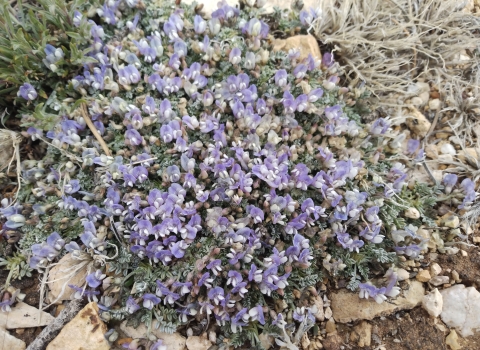The U.S. Fish and Wildlife Service announced today it is protecting the northern long-eared bat as a threatened species under the Endangered Species Act (ESA), primarily due to the threat posed by white-nose syndrome, a fungal disease that has devastated many bat populations.
At the same time, the Service issued an interim special rule that eliminates unnecessary regulatory requirements for landowners, land managers, government agencies and others in the range of the northern long-eared bat. The public is invited to comment on this interim rule as the Service considers whether modifications or exemptions for additional categories of activities should be included in a final 4(d) rule that will be finalized by the end of the calendar year. The Service is accepting public comments on the proposed rule until July 1, 2015 and may make revisions based on additional information it receives.
“Bats are a critical component of our nation’s ecology and economy, maintaining a fragile insect predator-prey balance; we lose them at our peril,” said Service Director Dan Ashe. “Without bats, insect populations can rise dramatically, with the potential for devastating losses for our crop farmers and foresters. The alternative to bats is greater pesticide use, which brings with it another set of ecological concerns.”
In the United States, the northern long-eared bat is found from Maine to North Carolina on the Atlantic Coast, westward to eastern Oklahoma and north through the Dakotas, reaching into eastern Montana and Wyoming. Throughout the bat’s range, states and local stakeholders have been some of the leading partners in both conserving the long-eared bat and addressing the challenge presented by white-nose syndrome.
“Michigan and other states collaboratively worked to provide critical information as the U.S. Fish and Wildlife Service evaluated the status of the northern long-eared bat,” said Keith Creagh, Director of the Michigan Department of Natural Resources. “The decision to list the bat as threatened with an interim 4(d) rule represents a biologically sound determination that will address the conservation needs of these bats while providing flexibility for those who live and work within the bats’ range. Looking ahead, we expect to continue working closely with the Service as we focus on finding the right solutions to this conservation challenge.”
The Service proposed the northern long-eared bat as “endangered” in October 2013 following severe population declines that have seen the species disappear from some traditional hibernation sites. However, during its review, the Service determined the northern long-eared bat meets the definition of “threatened.” Under the Act, an endangered species is currently in danger of becoming extinct, while a threatened species is likely to become endangered in the foreseeable future.
“In making this decision, we reviewed the best available scientific information on the northern long-eared bat, including information gathered from more than 100,000 public comments,” said the Service’s Midwest Regional Director Tom Melius. “We are listing this species because a disease – white-nose syndrome – is spreading and decimating its populations. We designed the 4(d) rule to provide appropriate protection within the area where the disease occurs for the remaining individuals during their most sensitive life stages, but to otherwise eliminate unnecessary regulation.”
The listing becomes effective on May 4, 2015, 30 days after publication of the final listing determination in the Federal Register.
Populations of the northern long-eared bat have declined dramatically in the eastern part of the bat’s range due primarily to white-nose syndrome, a disease that has killed millions of cave-hibernating bats of many species in the United States and Canada. Impact of disease is among the factors analyzed by the Service under the Endangered Species Act when a species is considered for listing.
The Service, states, federal agencies, tribes, conservation organizations and scientific institutions are working together on a national response team to address white-nose syndrome through disease monitoring and management, conservation and outreach. The Service has granted more than $20 million to institutions and federal and state agencies for research and response.
Some human activities also impact these species, particularly close to their hibernation sites, creating heightened challenges for bat populations already weakened by disease and underscoring the need to protect important habitat while research continues to develop a cure for white-nose syndrome.
White-nose syndrome has not yet been detected throughout the entire range of the northern long-eared bat, and will not likely affect the entire range for some years. The species appears stable in areas not yet affected by disease, mainly in the western part of its range. It also still persists in some areas impacted by white-nose syndrome, creating some uncertainty as to the timing of the extinction risk posed by the disease.
Under the ESA, the Service may implement special rules under section 4(d) for wildlife listed as threatened. Such rules enable the Service to tailor protections of the ESA to those that are “necessary and advisable to provide for the conservation of such species.” They also enable prohibitions that do not further the conservation of the species to be relaxed, reducing the regulatory burden on the public.
For areas of the country affected by white-nose syndrome, the measures provided in the interim 4(d) rule exempt “take” (a term under the ESA that includes harming, harassing or killing a listed species) resulting from certain activities. These activities include forest management practices, maintenance and limited expansion of transportation and utility rights-of-way, removal of trees and brush to maintain prairie habitat, and limited tree-removal projects, provided these activities protect known maternity roosts and hibernation caves. The interim 4(d) rule also exempts take resulting from removal of hazardous trees, removal of northern long-eared bats from human dwellings, and research-related activities.
These measures are designed to protect northern long-eared bats when they are most vulnerable, including when they are hibernating and during the two-month pup-rearing season from June through July.
In parts of the country not affected by white-nose syndrome, the 4(d) rule recognizes that activities that result in incidental take of bats are not imperiling the species. These activities will be exempt from the Act’s prohibitions. Purposeful take, however, other than removal of bats from dwellings, is prohibited.
You may submit comments on the interim 4(d) rule until July 1, 2015 by one of the following methods:
- Electronically: Go to the Federal eRulemaking Portal: regulations.gov. In the Search box, enter FWS–R5–ES–2011–0024, which is the docket number for this rulemaking. You may submit a comment by clicking on “Comment Now!”
- By hard copy: Submit by U.S. mail or hand-delivery to: Public Comments Processing, Attn: FWS–R5–ES–2011–0024; Division of Policy and Directives Management; U.S. Fish and Wildlife Service; 4401 N. Fairfax Drive, MS 2042–PDM; Arlington, VA 22203.
We request that you send comments only by one of the methods described above. We will post all comments on regulations.gov. This generally means that we will post any personal information you provide us.
Learn more about the final rule listing the northern long-eared bat as threatened and the interim 4(d) rule.



